Growing radishes in a greenhouse
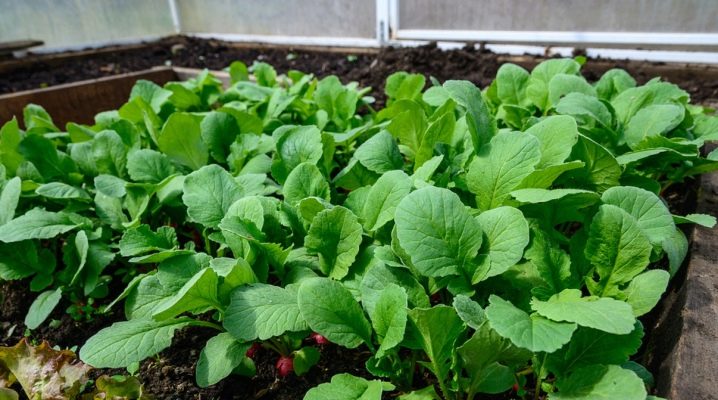
Radish is one of the fastest growing crops. It can be grown both outdoors and in greenhouses. Today we will talk about the features of growing such vegetation in greenhouse structures.
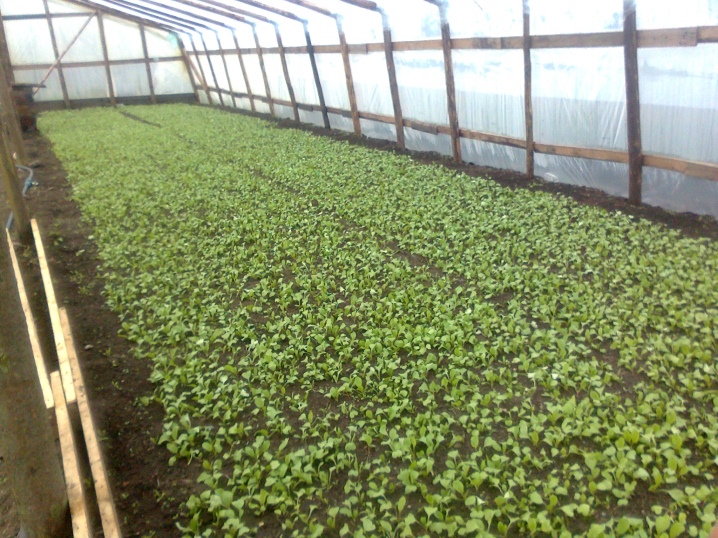
Variety selection
To begin with, you should select the most suitable varieties of radish for planting in greenhouses. The following types will be the best option.
- Zarya. This early ripening variety germinates quickly enough. As a rule, this takes no more than 25-30 days. The fruit will be round and dark red in color. Their flesh is juicy and soft.
- "Saksa"... This species is early maturing. The growing season is 20-25 days. It has a high yield. From 1 sq. m it will be possible to collect up to 3-3.5 kilograms of fruit. "Saksa" is considered to be resistant to droughts, temperature changes. The fruits grow round in shape with a rich color. Their flesh is white, juicy.
- "Helro"... This early maturing radish variety was specially bred for greenhouses and greenhouses. The fruits grow with a rich color, rounded shape. The species is considered fruitful, with 1 sq. m it will be possible to collect an average of 3-3.5 kilograms.
- "Greenhouse"... Root crops of this variety are round or oval in shape. There is a small tip on their surface. The average weight of one fruit is 25-30 grams.
- "Firstborn" (hybrid)... This type of radish allows you to get even, dense and large roots. Their colors will be bright red. The species matures approximately 15-18 days after planting.
- "Presto". This variety is very early. The crop can be harvested as early as 16-17 days after the formation of young shoots. The fruits grow firm and red.
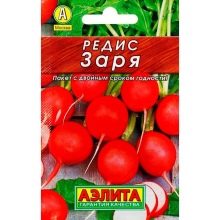
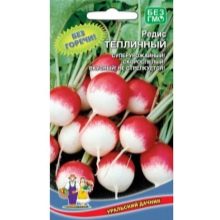

The necessary conditions
To get a good harvest of vegetables in such conditions, it is worth observing the basic growing conditions. The best option for such a culture would be a polycarbonate construction. In areas with severe winters, special winter greenhouses with heating should be built. Heating equipment can be either electric or gas.
Polycarbonate buildings are distinguished by good thermal insulation, increased transparency. They will be able to serve without breakdowns for many years. In addition, this type of greenhouse is very light, flexible, yet robust and reliable. If necessary, they can be moved to another location on the site.
Such designs have a neat aesthetic appearance. But it is worth noting that they have a relatively high cost.
Some gardeners place greenhouses made of glass and polymer materials on their plots, but they are significantly inferior to polycarbonate structures.
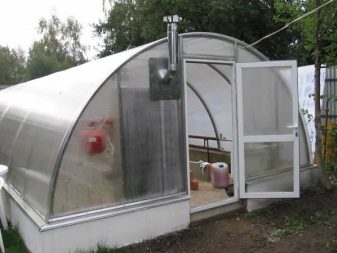
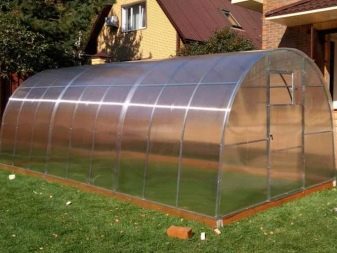
In any case, in order to obtain a good harvest, it is necessary to ensure the optimal temperature regime. During the day, it should be 18-20 degrees Celsius, and at night - 10-11 degrees Celsius.... In this case, the soil temperature should be at least 10-14 degrees.
It is also necessary to ensure the optimal level of humidity. It should be within 65-70%... Lighting is important. During the day, the structure should be well lit for 10-13 hours. On rainy days, you can use a special ceiling light for vegetation. Remember that even with excessive illumination, the culture can simply go into the arrow.
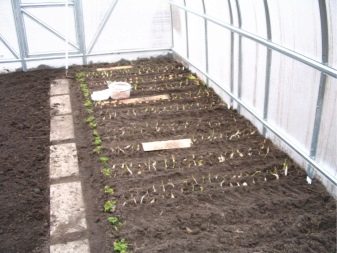
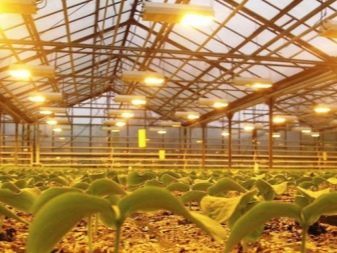
In any case, the structure must be as stable as possible in order to withstand gusts of wind, snowfalls and other atmospheric precipitation. In addition, the structure should have a streamlined shape.
In greenhouses and greenhouses, a ventilation system should be provided in advance for ventilation and for draining water. You can also install an automatic irrigation system and select a mode suitable for the crop.
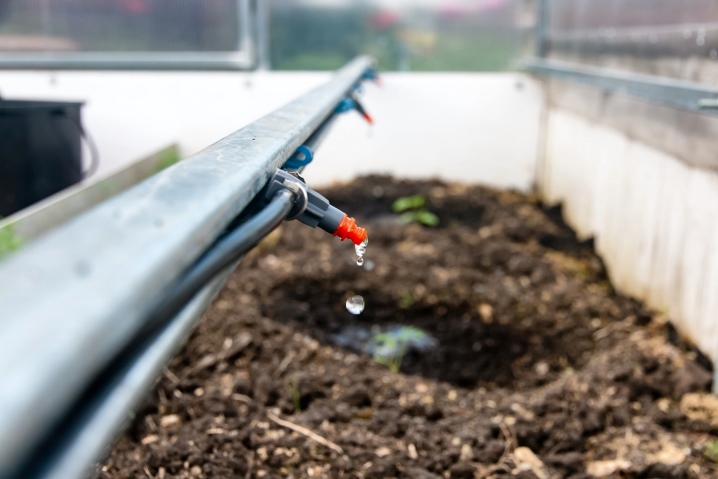
Landing dates
The timing of planting radishes in the greenhouse can vary significantly depending on the growing region. Landing can be carried out after the snow masses disappear, when the air temperature at night will be close to 0 degrees.
In the Urals, in the Moscow region, the culture can be planted in early spring. In Siberia, radish is planted much later.

Preparation
Before proceeding directly to planting radishes, it is necessary to carry out certain preparatory measures.
Seeds
It is important to properly prepare the seeds of the plant... To do this, the seeds are first sifted through a sieve (its holes should be no more than 2 millimeters). Then they are soaked in a solution of potassium permanganate for several hours. This procedure will protect the vegetation from various diseases and pests in the future.
After that, the radish seeds are soaked in a solution with wood ash (there is 1 teaspoon of ash per 100 milliliters of liquid). This procedure will stimulate plant growth. Further, the planting material is well dried on a paper towel.


The soil
The soil should also be prepared in advance. Remember, radishes are best grown on land with neutral acidity.... Otherwise, the vegetation will often hurt. The soil mixture can be different. Most often, for its preparation, garden soil and humus are mixed together; you can also make a mass from humus, sod soil and peat, from sod soil and soil taken from a greenhouse structure. If you do not want to prepare your own soil mixture, you can buy it ready-made in stores.
Soil preparation must be carried out already in the fall. It will be necessary to add mineral dressing. The best option would be superphosphate (40 grams per 1 sq. M planting)... You can additionally add organic matter (a bucket of compost per 1 square meter of land). The latter is used in cases where the land is already severely depleted.
If the soil is too heavy, then it is worth adding sand to it. Immediately after fertilization, the soil is carefully dug up and then leveled. Next, the beds are formed, they should be 1 meter wide. In this form, everything is left until the onset of spring.

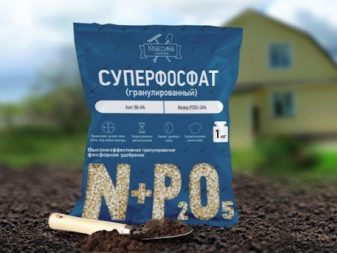
A few days before planting, the beds are covered with a special protective film. This is done so that the soil warms up well enough.
How to plant the material correctly?
We will now take a look at how to properly plant radish seeds in a greenhouse. In early spring, after the snow melts, the covering material is removed from the beds. Then seeds are planted in them. They will have to go 1 centimeter deep into the ground.
Remember that the distance between individual seeds should be about 2 cm, the distance between individual rows should be 5-7 cm. Per 1 sq. m of land will account for an average of 4-5 grams of planting material. Sow it as carefully as possible so as not to damage it.

You can plant seeds in winter. In this case, a special cassette landing method is used. You will need to process the cassettes with containers first. For this, various disinfectants are used.
With this technology, only the largest and most thoroughly dried radish seeds should be used.... A soil mixture is poured into each compartment. Then the seeds are planted in each such cell one by one. All this is lightly sprinkled with sand.
After that, each container with seed is watered. Then watering is carried out every day, but in small quantities.
If vegetation is grown in winter, then it must be illuminated for at least 12-13 hours a day.
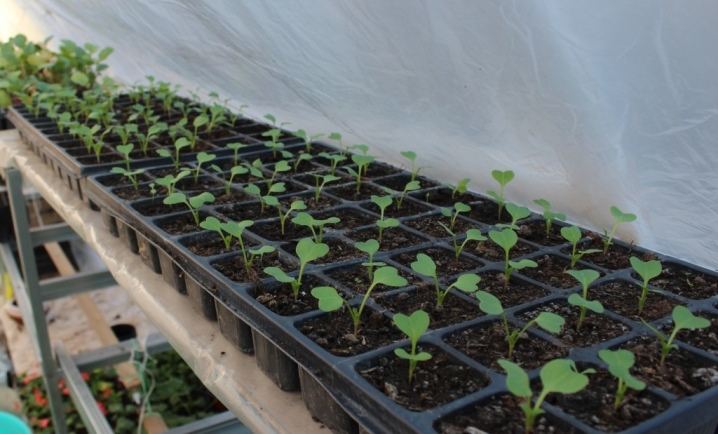
Follow-up care
Once planted, the radishes will need proper care.
- Ventilation and humidification. The planted crop will require periodic and abundant watering. In too hot weather, these plants need to be moistened every day. In cool and cloudy weather, such procedures are carried out only once every 2-3 days. Watering should be done to a depth of 10-15 centimeters. If the soil is too dry, then the fruits will gradually begin to coarse. In this case, the plants are often not set. With excessive waterlogging, the roots will quickly crack. Immediately after watering, the culture must be well ventilated, since at a high humidity level in the greenhouse, the radish will quickly be affected by the black leg.
- Mulching... In order to reduce the volatility of water and retain it in the ground, it is necessary to spread mulch around each bush. It is better to use peat or humus as it. The thickness of such a protective layer should be up to 1 centimeter.
- Thinning... If the seedlings are placed too close to each other, then thinning will need to be carried out. Remember that the distance between the plants should be 2-3 cm. When performing the procedure, only weak and diseased shoots should be removed.
- Top dressing... Radish also needs frequent feeding. For such a culture, nutrient formulations with nitrogen will be the best option. At the same time, they are introduced after irrigation (20-25 grams of substance should fall on 1 sq. M. Of land). It is recommended to fertilize the soil a couple of times per season.
- Loosening and weeding of beds. Such a procedure should be carried out only if necessary.
- Protection against harmful organisms... In order to protect the plants, it is better to treat them with a mixture of tobacco powder and ash (in proportions 1: 1).
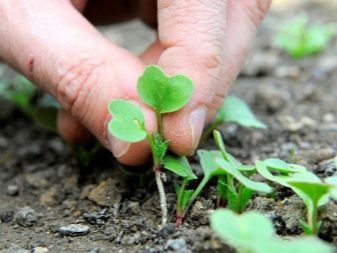
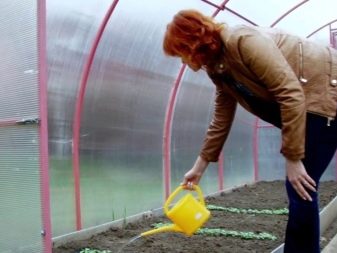
Growing rules in a greenhouse without heating
Now we will analyze how to properly grow this culture in an unheated building. Such vegetation will not be afraid of frost. Shoots can easily withstand temperatures as low as -5 degrees. In this case, the beds still need to provide additional heating. For these purposes, it is better to lay out manure under planting. It must be fresh. Beforehand, it should be well moistened and wait for it to dry slightly.
If there is no such fertilizer, then instead of it, you can take hay, straw or wood shavings. Such material is laid and compacted with a layer of at least 25-30 centimeters. After that, it is poured over with boiling water and sprinkled with earth. Planting can be done in a few days.
When planting, the seed is deepened by 1 cm. The width between the rows should be at least 7 cm. With a thickened planting, the seedlings will have to be thinned out by a few centimeters.

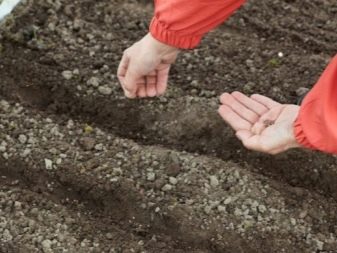
After planting, it will be necessary to remove weeds in a timely manner. It is also important to regularly loosen the soil and water the crop 1-2 times a day, for this only warm liquid (20-22 degrees) is used.
When the first shoots appear, it is better to apply nitrogen-containing fertilizing. In order to maximize the growth of vegetation, it can be fed with formulations with potassium. With a sharp and significant drop in temperature, it is better to additionally protect the crop. To do this, it is sprayed with water and covered with a special film. Wet air masses will accumulate under the covering material, they will not allow the radish to freeze. In the daytime, the film material must be removed.
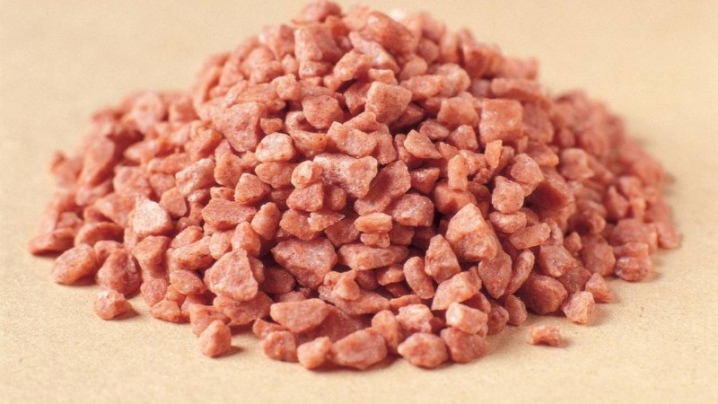
Harvesting
Vegetables planted in a closed building can be harvested in several steps. In this case, the first assembly should be performed approximately 1-1.5 months after sowing. Most often, the harvest reaches 1.5-2 kilograms per 1 sq. m landings.
It is not recommended to delay the assembly of root crops. Vegetables can be picked when they are medium in size and have their characteristic bright color.
Radish varieties with white tips must be removed from the beds on time, as the manufacturers advise.... Otherwise, the roots may simply become hollow.
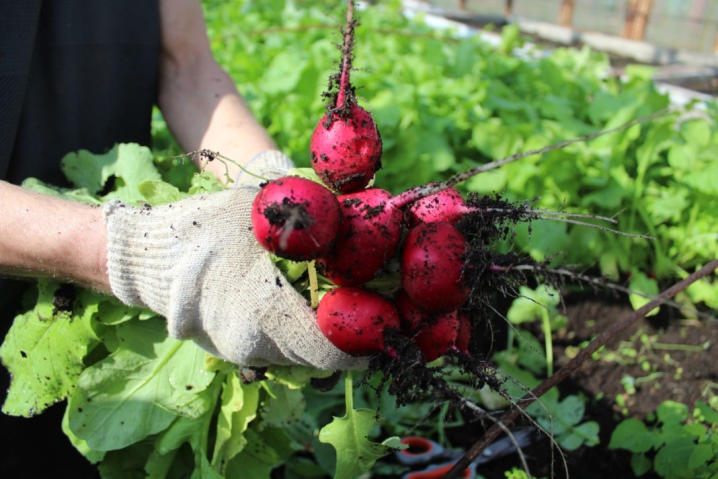
A few hours before the start of harvesting, it is recommended to water the vegetation with warm water. It is best to moisten the soil in the early morning, and pluck the crop in the afternoon.
The collected radishes will need to be rinsed well under running water and dried. In this form, root vegetables can be stored in a refrigerator for 3-4 weeks. If you plan to store it for a longer period, then you can use wooden boxes.
Their bottom is completely covered with polyethylene. Next, the plucked radish is carefully laid out there. It is lightly sprinkled with a mixture of earth and peat. This mass will protect the crop from rotting.
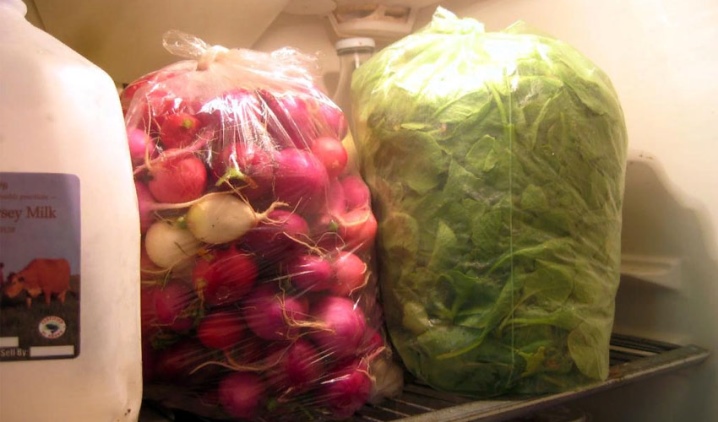









The comment was sent successfully.